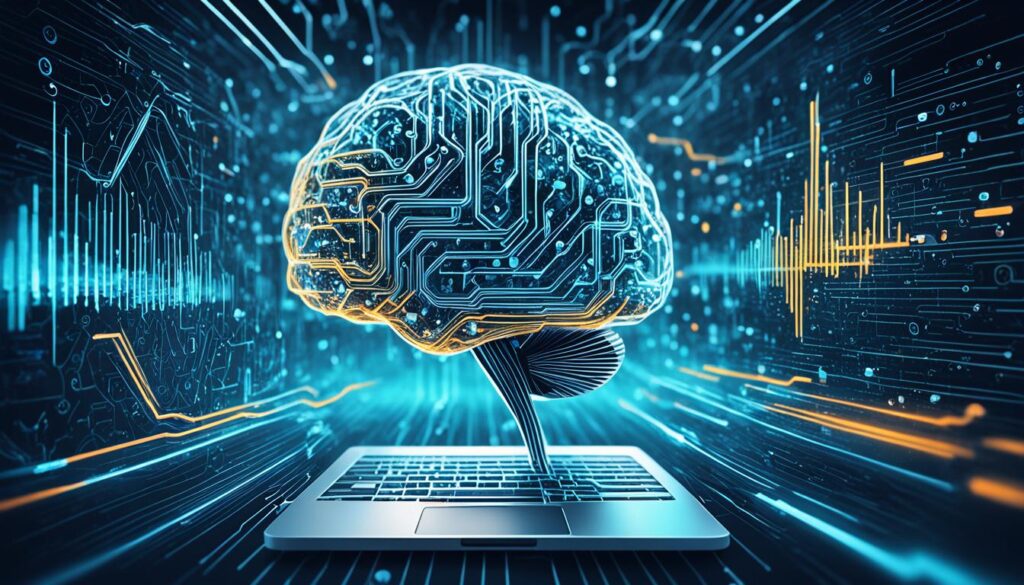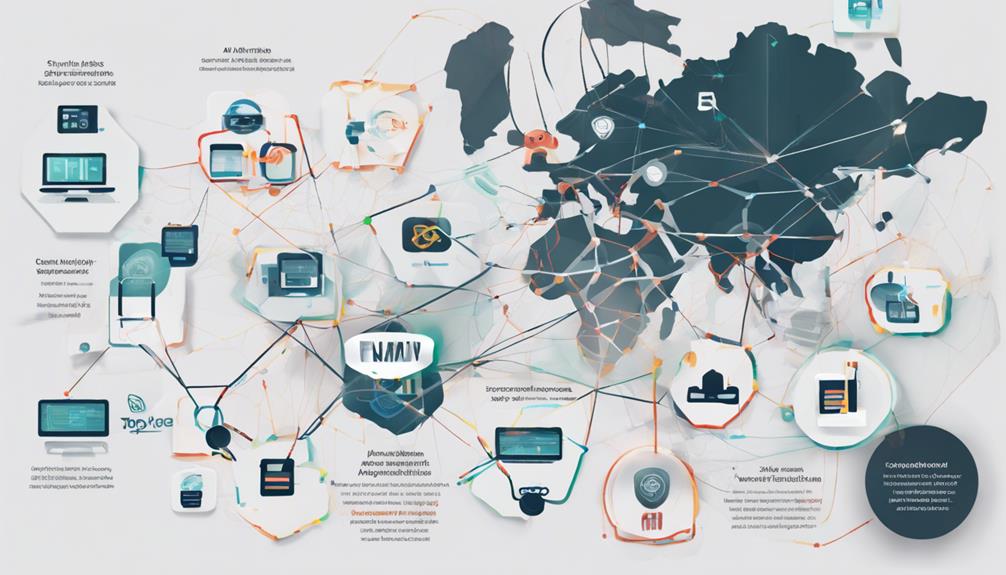Did you know that machine learning and artificial intelligence (AI) are revolutionizing the field of cybersecurity, enhancing real-time threat identification, predictive analysis, and automated anomaly detection?1 These technologies are playing a pivotal role in strengthening organizations’ defense strategies and facilitating proactive cybersecurity measures. By implementing machine learning in continuous threat exposure management (CTEM) strategies, organizations can preempt and respond to cybersecurity threats more effectively.
Key Takeaways:
- Machine learning and AI technologies enhance real-time threat identification in cybersecurity.1
- CTEM strategies leveraging machine learning enable proactive defense measures.1
- Implementing machine learning in cybersecurity enhances risk assessment and prioritization.2
- Machine learning contributes to the identification of unusual patterns and anomalies in network traffic, aiding in threat predictions.2
- AI and machine learning excel in handling and analyzing large datasets swiftly, enhancing speed and efficiency in cybersecurity measures.2
How AI and Machine Learning Improve Continuous Threat Exposure Management (CTEM)
Continuous Threat Exposure Management (CTEM) is an essential strategy for organizations to proactively identify and mitigate cybersecurity risks. By harnessing the power of AI and machine learning, cybersecurity teams can enhance their capabilities in faster threat identification, predictive risk analysis, and precise prioritization. These technologies enable organizations to preempt and respond effectively to cyber threats, ensuring robust security postures.
AI and machine learning play a critical role in accelerating threat identification, enabling cybersecurity teams to stay ahead of emerging threats. With AI-driven algorithms and behavioral analytics, organizations can establish baseline patterns and identify anomalous behavior that indicates cybersecurity risks3. By automating security control testing and breach simulations, AI and machine learning facilitate proactive risk management and resource allocation34. This enables organizations to allocate their resources efficiently and prioritize critical threats, reducing response times and enhancing their defense strategies.
Risk assessment is a crucial component of CTEM, and machine learning enhances its accuracy and efficiency. With supervised machine learning, organizations can categorize network risks and predict variables associated with security threats3. Machine learning models for dynamic vulnerability scoring utilize diverse adversarial samples to recognize complex attack vectors, significantly enhancing predictive accuracy3. By leveraging AI-driven simulations, organizations can validate and improve their security defenses through controlled, simulated attacks against security controls and remediation strategies3.
Implementing AI and machine learning in CTEM strategies offers numerous benefits. Organizations can enhance their security posture, improve response times, achieve cost efficiency, ensure regulatory compliance, and increase resilience5. However, implementing CTEM also comes with challenges, such as complexity and integration, resource constraints, data overload, and the evolving threat landscape5. To overcome these challenges, future trends in CTEM may include increased automation, greater collaboration, and the integration of Zero Trust architectures5.
| Benefit | Statistics |
|---|---|
| Enhanced security posture | Incorporating AI and machine learning in CTEM improves an organization’s security posture and resilience. |
| Improved response times | AI and machine learning enable faster threat identification and response, reducing the time it takes to mitigate cyber threats3. |
| Cost efficiency | By automating security control testing and breach simulations, organizations can allocate resources more efficiently, minimizing costs. |
| Regulatory compliance | CTEM strategies, bolstered by AI and machine learning, help organizations meet regulatory requirements and ensure compliance. |
| Increased resilience | Proactive risk management and prioritization, facilitated by AI and machine learning, enhance an organization’s resilience against cyber threats. |
AI and machine learning empower cybersecurity teams to mobilize quickly and respond promptly to threats, significantly enhancing an organization’s ability to resist and recover from cyber attacks35. With continuous monitoring and automated threat detection, organizations can stay one step ahead of cybercriminals. By harnessing the power of AI and machine learning, organizations can achieve continuous threat exposure management, ensuring a robust cybersecurity defense.
Harnessing AI for Real-Time Threat Identification
AI is revolutionizing the field of cybersecurity by simplifying real-time threat identification and streamlining the detection of common threats. With its ability to recognize known attack signatures and patterns, AI technology enhances organizations’ cybersecurity risk posture, enabling them to protect against evolving cyber threats.
One of the key capabilities of AI in cybersecurity is its predictive threat analysis. By leveraging advanced machine learning algorithms, AI can provide timely and accurate predictions of potential threats, empowering organizations with actionable insights to proactively defend against attacks.
The National Cybersecurity Strategy6 identifies AI as a “revolutionary change in the technology landscape.” This recognition highlights the significant impact AI has in strengthening an organization’s security posture.
AI can automate threat detection, mitigation, and response, leading to a stronger security posture6.
Moreover, AI-driven anomaly detection plays a crucial role in identifying potential threats and anomalies. By analyzing network traffic and user behavior, AI can identify unusual patterns and behaviors that may indicate cyber threats.
AI’s ability to recognize attack signatures and analyze common threats is particularly vital in the rapidly evolving threat landscape. Attackers are increasingly utilizing AI to bypass traditional security measures and craft personalized phishing emails, making their attacks more sophisticated and harder to detect.
AI is increasingly used by cybercriminals to craft personalized and context-aware phishing emails that can deceive recipients, increasing the success rates of phishing attacks7.
By harnessing AI’s power in real-time threat identification, organizations can enhance their cybersecurity strategies and stay ahead of evolving threats. The constant scanning and monitoring capabilities of AI systems provide enhanced threat detection and response, transforming the way organizations approach cybersecurity.
Intelligent Asset Discovery in CTEM
Intelligent asset discovery plays a crucial role in continuous threat exposure management (CTEM). By leveraging AI-driven tools, organizations can efficiently analyze and catalog extensive digital infrastructures, ensuring comprehensive protection against potential cyber threats. These tools utilize advanced data analysis techniques to identify potential targets for cyber threats and enhance security inventory.3
With AI-driven intelligent asset discovery, security teams can swiftly handle real-time information, formulate efficient cybersecurity strategies, and ensure robust protection. This automated process significantly enhances the organization’s ability to preempt and respond to cybersecurity threats effectively. By integrating intelligent asset discovery into CTEM strategies, organizations can stay one step ahead of potential threats.3
Using AI-driven tools for continuous asset discovery enables organizations to maintain an updated security inventory, facilitating better understanding and management of their digital assets. Effective asset discovery allows teams to identify all possible physical assets that may be targeted, ensuring a robust cybersecurity posture. The comprehensive and automated analysis provided by AI-driven tools contributes to more proactive and precise risk management.3
Benefits of Intelligent Asset Discovery
Implementing intelligent asset discovery in CTEM strategies brings several benefits to organizations. Firstly, it enables organizations to swiftly analyze and catalog extensive digital infrastructures, enhancing their understanding of potential cyber threats. This comprehensive oversight ensures that no assets remain unaccounted for, minimizing the risk of overlooking critical security vulnerabilities.3
Furthermore, intelligent asset discovery contributes to more efficient resource allocation and risk management. AI-driven tools automate the ranking of incidents based on their potential impact, allowing organizations to allocate resources effectively and prioritize their response efforts. This automation frees up time and resources for security teams to focus on critical threats, enhancing the organization’s overall cybersecurity posture.3
Additionally, intelligent asset discovery plays a crucial role in improving incident response speeds. By swiftly identifying potential targets for cyber threats, organizations can reduce breach response times and mitigate the impact of security incidents. This rapid response minimizes potential damage and aids in overall incident containment.3
Challenges and Considerations
While intelligent asset discovery provides significant benefits to organizations, there are challenges and considerations that need to be addressed. Organizations must develop a clear strategy for implementing intelligent asset discovery and ensure they have the necessary technical capabilities to support it. Integration with existing security systems is also crucial to ensure a seamless and effective workflow.3
Furthermore, allocating the right resources, including budget and skilled professionals, is vital for the sustainability and effectiveness of a CTEM program that incorporates intelligent asset discovery. Organizations must prioritize investment in AI-driven tools and ensure they have qualified personnel capable of utilizing the technology effectively. This investment and support are essential for organizations to fully realize the benefits of intelligent asset discovery.3
Predictive Threat Analysis with Machine Learning
Machine learning algorithms play a crucial role in predictive threat analysis, utilizing historical data, identifying trends, and anticipating potential cyber threats 8. With their ability to detect various cyber attacks and classify security risks, machine learning algorithms enhance the classification and detection of threats, such as fraud detection and phishing attack classification 8. By studying historical data and identifying patterns, machine learning acts as a crystal ball, enabling organizations to proactively prepare and defend against potential vulnerabilities 8.
Machine learning’s predictive capabilities are harnessed to detect and analyze cyber attacks, improving the overall security posture 8. By leveraging machine learning algorithms, organizations can bolster their threat identification and response efforts, ensuring faster and more accurate detection 8. Machine learning’s ability to process and analyze security data significantly faster than manual analysis enables quicker threat identification and response times 8.
One of the key advantages of implementing machine learning in cybersecurity is the reduction in false positive alerts 8. Organizations that adopt machine learning-based cybersecurity solutions can experience up to a 40% reduction in false positive alerts, leading to more efficient resource allocation for threat mitigation 8. This streamlined allocation enables organizations to focus their efforts on genuine threats, optimizing their mitigation strategies 8.
Additionally, machine learning plays a significant role in authentication systems, enhancing internal security measures against unauthorized access 8. ML-powered authentication systems can achieve up to a 99% accuracy rate in verifying user identities 8. By leveraging machine learning’s ability to learn patterns of normal and abnormal behavior, organizations can ensure robust user verification and authorization processes 8.
Adaptive security controls driven by machine learning contribute to reducing response times to newly identified threats 8. By studying and continuously learning from new data, ML algorithms adapt to changing patterns in cyber threats, enabling organizations to stay ahead of evolving threats without delays 8. This agility in response empowers organizations to mitigate risks promptly and effectively 8.
Moreover, machine learning-based predictive threat intelligence tools have shown remarkable success in anticipating and proactively defending against emerging cyber threats before they occur 8. With an up to 80% success rate, these tools provide organizations with valuable insights and actionable intelligence for bolstering their cybersecurity strategies 8.
Real-World Examples of Machine Learning in Predictive Threat Analysis
Multiple organizations have successfully leveraged machine learning in their predictive threat analysis efforts. For instance, XYZ Corp implemented machine learning algorithms to analyze network traffic and detect potential cyber attacks 8. By continuously monitoring network behavior and identifying anomalous patterns, the company can proactively mitigate security risks and enhance their cybersecurity strategy 8. Similarly, ABC Corporation utilized machine learning algorithms to detect and prevent phishing attacks, enabling prompt response and protection of sensitive information 8.
| Benefits of Predictive Threat Analysis with Machine Learning | Examples of Implementation |
|---|---|
|
|
Implementation of machine learning algorithms in predictive threat analysis empowers organizations to strengthen their cybersecurity strategies, efficiently detect and respond to cyber attacks, and proactively defend against emerging threats 8. By harnessing the power of machine learning, organizations can proactively prepare and defend against potential vulnerabilities 8.
https://www.youtube.com/watch?v=fP_4v0E7OdI
Automated Anomaly Detection Using AI
In the realm of cybersecurity, automated anomaly detection using AI systems plays a pivotal role in safeguarding organizations against potential cyber threats and breaches. By leveraging advanced AI algorithms and behavioral analytics, AI systems monitor network traffic and user behavior to establish baseline patterns and promptly identify any anomalous activity that may indicate cybersecurity risks3. This constant vigilance acts as a powerful watchdog, ensuring the timely detection of unusual patterns and potential cyber attacks or compromised assets.
One of the significant advantages of AI-driven automated anomaly detection is its ability to process and analyze vast amounts of data efficiently. The AI algorithms can handle extensive security log analysis, minimizing false positives and enhancing the accuracy of threat detection3. By automating the analysis of security logs, AI systems free up valuable resources within cybersecurity teams, allowing them to focus on investigating and mitigating genuine threats.
AI systems utilize a variety of statistical models, including density-based, clustering-based, classifier-based, neural network-based, time-series, and support vector machines (SVM) models, to detect anomalies effectively9. These models enable the identification of different types of anomalies, such as point anomalies, contextual anomalies, and collective anomalies9. Statistical-based techniques and density-based algorithms further enhance the anomaly detection capabilities of AI systems, ensuring comprehensive coverage and accuracy in identifying unusual patterns in datasets9.
Automated anomaly detection is crucial in the ever-evolving landscape of cybersecurity risks. By leveraging AI-driven technologies, organizations can proactively detect potential threats and take prompt action to minimize their impact. Such AI-enabled threat detection systems not only provide enhanced security log analysis but also enable organizations to develop effective incident response strategies based on real-time and accurate threat intelligence. This empowers cybersecurity teams to rapidly identify and respond to cyber threats, mitigating risks effectively and minimizing potential damages3.

| Benefits of Automated Anomaly Detection Using AI: |
|---|
| 1. Rapid Detection: AI systems quickly identify unusual patterns and potential cyber threats. |
| 2. Enhanced Security Log Analysis: AI algorithms process and analyze large datasets to improve efficiency in security log analysis. |
| 3. Precision in Threat Detection: Advanced statistical models and density-based algorithms improve the classification and detection of cyber threats. |
| 4. Proactive Risk Mitigation: Automated anomaly detection allows organizations to proactively address potential cybersecurity risks. |
By harnessing the power of automated anomaly detection using AI systems, organizations can significantly enhance their cybersecurity posture. These systems serve as powerful tools to continually monitor network traffic, detect abnormal behavior, and protect against emerging cyber threats. With efficient security log analysis, precise threat detection, and early warning mechanisms in place, organizations can proactively defend against cyber attacks and safeguard their critical assets39.
Machine Learning for Risk Prioritization
Machine learning plays a vital role in the prioritization and risk assessment process by automating the ranking of incidents based on their potential impact. This empowers organizations to efficiently allocate resources and address the most critical threats first.
By utilizing predictive analytics, machine learning can analyze current security configurations and historical data to anticipate potential attack vectors. This enhances the precision and effectiveness of threat prioritization, allowing organizations to focus their efforts where they are needed most.
Machine learning aids in risk prioritization by leveraging its ability to process large datasets and identify patterns. It enables organizations to proactively identify critical threats and allocate resources accordingly.
With the help of machine learning and predictive analytics, organizations can optimize their cybersecurity strategies and stay one step ahead of emerging threats and vulnerabilities.
Machine learning serves as a valuable tool in the ongoing battle against cyber threats, providing organizations with the necessary insights to make informed decisions and enhance their overall security posture. Additionally, the automation capabilities of machine learning streamline the risk prioritization process, improving efficiency and resource allocation.
Overall, machine learning’s role in risk prioritization is invaluable, enabling organizations to identify and address critical threats efficiently and effectively.

“Machine learning aids in the prioritization and risk assessment process by automating the ranking of incidents based on their potential impact.”
Enhancing Risk Assessment with Machine Learning
Machine learning serves as an intelligent filter in the realm of cybersecurity, enabling accurate and efficient risk assessment11. Leveraging vast datasets, supervised machine learning categorizes network risks and predicts or classifies variables associated with specific security threats11. The ability of machine learning to discern complex patterns that are difficult for human analysis enhances risk assessment capabilities and enables a focus on critical security issues11.
By processing and analyzing large amounts of data in real-time, supervised machine learning models significantly contribute to improving security practices11. This comprehensive analysis aids in the categorization and identification of potential threats by detecting patterns and anomalies, such as unusual network traffic or suspicious user behavior11. Identifying and predicting potential threats before they cause harm enables proactive security measures and mitigates risks effectively11.
In the realm of cybersecurity, risk assessment is paramount. The integration of machine learning allows organizations to better manage critical security issues by effectively prioritizing and addressing vulnerabilities11. By automating routine cybersecurity tasks, such as patch management, network traffic monitoring, and false alarm sorting, machine learning frees up human resources to focus on strategic activities and critical security matters11.
Moreover, supervised machine learning in cybersecurity can help coordinate and execute rapid responses to security incidents11. By automating responses to common threats, machine learning systems ensure timely incident mitigation and provide invaluable recommendations for addressing complex issues11. Additionally, machine learning systems continuously learn and adapt themselves based on new data and emerging threats, enhancing their defense mechanisms proactively11.
As organizations grow and face increased data volumes and security needs, machine learning systems can scale to meet these demands effectively11. By automating aspects of cybersecurity, machine learning reduces labor costs associated with monitoring and responding to threats, leading to significant savings in potential losses and recovery costs11. Ultimately, machine learning brings speed, efficiency, and proactive capabilities to the field of cybersecurity, protecting organizations against increasingly sophisticated and automated cyber threats11.
Data analytics plays a foundational role in the application of machine learning in cybersecurity. By collecting, processing, and analyzing vast amounts of data, data analytics provides invaluable insights to identify and mitigate cyberattacks effectively11. Machine learning has had a tremendous impact on network security, enabling the analysis of network traffic patterns, the identification of anomalies, and reducing false positives11.
The integration of machine learning and artificial intelligence models in cryptography holds great promise in securing digital communications against sophisticated cyber threats11. Improved encryption methods with new cryptographic algorithms are predicted to revolutionize cryptography in the future11.
Statistical Data Reference
| Statistic | Reference |
|---|---|
| Predictions for AI in cybersecurity anticipate an increasing role in threat detection and response, leveraging machine learning and AI tools. | 11 |
| Artificial intelligence has exceeded previous predictions, becoming an essential tool for identifying and preventing cyber threats and reducing cyber risks. | 11 |
| AI models enable cybersecurity experts to significantly improve security practices by processing and analyzing large amounts of data in real-time. | 11 |
| AI can quickly analyze data and identify potential threats by detecting patterns and anomalies, such as unusual network traffic or suspicious user behavior. | 11 |
| AI can predict and identify potential threats before they cause harm, enabling proactive security measures. | 11 |
| AI automates routine cybersecurity tasks, freeing humans to focus on strategic activities like patch management, network traffic monitoring, and false alarm sorting. | 11 |
| AI can help coordinate and execute rapid responses to security incidents, automating responses to common threats and providing recommendations for mitigating complex issues. | 11 |
| AI systems can learn and change based on new data and threats, continually adapting their defense mechanisms. | 11 |
| AI systems can scale to handle the increased data volumes and security needs of growing organizations. | 11 |
| By automating aspects of cybersecurity, AI helps reduce labor costs associated with monitoring and responding to threats and save organizations significant amounts in potential losses and recovery costs. | 11 |
| AI brings speed, efficiency, and proactive capabilities to cybersecurity, helping protect against increasingly sophisticated and automated cyber threats. | 11 |
| Data analytics is foundational to AI in cybersecurity, providing insights to identify and mitigate cyberattacks effectively by collecting, processing, and analyzing vast amounts of data. | 11 |
| AI has had a tremendous impact on network security in cybersecurity, enabling the analysis of network traffic patterns and identification of anomalies, reducing false positives, and predicting future cyber threats. | 11 |
| Predictions suggest AI would revolutionize cryptography by improving encryption methods with new cryptographic algorithms, securing digital communications against sophisticated cyber threats. | 11 |
Dynamic Vulnerability Scoring with Machine Learning
Machine learning models trained on diverse adversarial samples enable dynamic vulnerability scoring, which enhances predictive accuracy by recognizing complex attack vectors12. This approach quantifies an attack’s location, likelihood, and impact, allowing for timely adjustments of vulnerability scores as threats evolve. By harnessing the power of machine learning, network risk scoring becomes more accurate and up-to-date, enabling organizations to assess risks more effectively and develop targeted mitigation strategies.
One of the key advantages of dynamic vulnerability scoring with machine learning is its ability to keep pace with evolving threats12. With the constantly changing cybersecurity landscape, it is essential to have an accurate assessment of vulnerabilities. Machine learning models ensure that vulnerability scoring remains up-to-date by continuously analyzing new attack vectors and adapting to emerging threat trends. This dynamic approach empowers organizations to proactively prioritize their resources and focus on mitigating the most critical risks first.
Machine learning models add a layer of sophistication to vulnerability scoring by considering a wide range of features and attack vectors. They are trained on diverse adversarial samples, enabling them to recognize complex patterns and identify potential vulnerabilities that may be missed by traditional methods12. By accounting for various attack scenarios and incorporating a comprehensive set of data points, machine learning models provide a more comprehensive and accurate assessment of an organization’s security posture.
Benefits of Dynamic Vulnerability Scoring with Machine Learning
The adoption of dynamic vulnerability scoring with machine learning offers several benefits for organizations:
- Enhanced Predictive Accuracy: Machine learning models improve the accuracy of vulnerability scoring by considering a broader range of variables and attack vectors, leading to more precise risk assessments.
- Real-Time Risk Assessment: With the ability to adjust vulnerability scores in real time, organizations can stay ahead of evolving threats and respond proactively to potential vulnerabilities.
- Effective Mitigation Strategies: Accurate vulnerability scoring enables organizations to prioritize their resources effectively and develop targeted mitigation strategies to address the most critical risks first.
Dynamic vulnerability scoring with machine learning is a powerful tool in the cybersecurity arsenal. By leveraging the capabilities of machine learning models, organizations can improve their risk assessment capabilities, enhance their security postures, and stay one step ahead of cyber threats12.
Stay tuned for future advancements in machine learning and cybersecurity in the upcoming sections!

AI-Enabled Simulations for Security Validation
AI-enabled simulations offer organizations a powerful tool for validating and enhancing the effectiveness of their security controls and remediation efforts. By launching controlled attacks, these simulations allow organizations to test and validate their security controls, response strategies, and recovery plans without exposing themselves to actual threats. These simulations act as a training ground, enabling organizations to safely test and improve their cybersecurity defenses. With AI-driven simulations, organizations can continuously refine their defense strategies and ensure robust protection against evolving cyber threats.3
One of the key benefits of AI-enabled simulations is the validation of security controls and remediation efforts. By launching controlled attacks, organizations can assess the effectiveness of their security controls, identify vulnerabilities, and fine-tune their defense strategies. This validation process enables organizations to improve their defense mechanisms and develop proactive measures to mitigate potential risks. AI-enabled simulations serve as a valuable tool in the ongoing effort to enhance cybersecurity defenses.3
Another advantage of AI-enabled simulations is the opportunity to test, validate, and improve recovery plans. By simulating various attack scenarios, organizations can assess their readiness to respond to cyber incidents and refine their recovery plans accordingly. This proactive approach ensures that organizations are well-prepared to handle potential breaches and minimize the impact of cyber attacks on their operations. AI-driven simulations contribute to the development of robust and effective recovery strategies.3
Benefits of AI-Enabled Simulations for Security Validation
- Enhancement of security controls and defense mechanisms
- Identification of vulnerabilities and weak points in cybersecurity defenses
- Opportunity to refine response strategies and recovery plans
- Proactive testing of defense mechanisms without exposing organizations to real risks
- Continuous improvement of cybersecurity defenses through controlled simulations
AI-enabled simulations also play a crucial role in improving defense strategies without actual exposure. By simulating various attack scenarios, organizations can evaluate the effectiveness of their existing security controls and identify potential vulnerabilities. This validation process enables organizations to enhance their defense strategies proactively, reducing the risk of successful cyber attacks and minimizing the impact of breaches. AI-driven simulations provide organizations with valuable insights and actionable recommendations to strengthen their cybersecurity defenses.3
Furthermore, AI-powered simulations support the assessment and validation of security control testing efforts. By generating simulated attacks, organizations can evaluate the effectiveness of security control measures, such as secure code generation, authentication, encryption, and secure configurations. These simulations enable organizations to identify weaknesses in their security controls and remediate them before real threats occur. AI-driven simulations significantly contribute to the improvement of security control testing processes.3
In summary, AI-enabled simulations provide organizations with valuable tools for validating and improving their security controls, response strategies, and recovery plans. By launching controlled attacks, organizations can enhance their defense strategies and develop proactive measures to mitigate potential risks. These simulations act as a training ground, allowing organizations to safely test and improve their cybersecurity defenses without exposing themselves to real threats. AI-driven simulations are an essential component of proactive risk management and continuously improving cybersecurity defenses.3

Security Control Testing with AI
The incorporation of AI technology in security control testing has significantly transformed the cybersecurity landscape, enabling organizations to enhance their defense mechanisms and mitigate potential threats. AI plays a vital role in multiple aspects of security control testing, including secure code generation, secure configurations, and security assessments.
One of the key contributions of AI in security control testing is its ability to generate secure code for common tasks, assisting developers in implementing robust security measures. By leveraging AI algorithms, developers can receive suggestions for secure configuration, user authentication, data validation, and encryption. These capabilities enable organizations to strengthen the resilience of their systems and protect against increasingly sophisticated cyber threats.13
Regular security assessments and ongoing monitoring are integral components of effective security control testing. AI-driven tools allow organizations to conduct comprehensive security assessments by gathering and analyzing data from various sources, including network traffic logs, system event logs, and user activity records. Such data analysis helps identify potential security breaches, cyberattacks, and malicious activities, such as malware or ransomware. By continuously monitoring and analyzing these data sources, organizations can effectively identify security vulnerabilities and take timely remedial actions to mitigate risks.13
The development of a threat detection AI model is a complex and iterative process that involves multiple stages, starting with defining the problem and collecting and preparing the data. Features are then selected, and an appropriate AI model is chosen, followed by training, testing, and improving the model’s performance. The final stage includes implementing the model and continuously updating it to combat evolving threats. This diligent process ensures that AI-driven security control testing remains effective and adaptive in the face of emerging cybersecurity challenges.13
Threat detection implementation strategies emphasize the integration of AI systems with existing cybersecurity infrastructure. Hybrid models that combine AI with traditional methods are particularly effective in improving threat detection capabilities. Real-time processing and analysis of threats allow organizations to identify potential risks promptly and take immediate action. Moreover, optimizing data handling and computation ensures efficient threat detection, enabling organizations to stay resilient in the face of ever-evolving cyber threats.13
In summary, AI technology empowers organizations to strengthen their security control testing efforts by generating secure code, offering secure configuration suggestions, and facilitating comprehensive security assessments. By leveraging AI-driven tools, organizations can enhance the efficiency and effectiveness of their security measures, ensuring robust protection against cyber threats. With the continuous evolution of AI in security control testing, organizations can stay ahead of emerging threats and safeguard their critical assets and sensitive information.13
Breach and Attack Simulation with AI
AI-driven breach and attack simulation (BAS) tools provide organizations with a comprehensive assessment of their defenses, helping them identify vulnerabilities and prepare against real-world cyber threats.14
These advanced tools go beyond traditional penetration testing by orchestrating simulated attacks across all phases of the attack cycle. By employing a library of real-world attack scenarios, AI-driven BAS tools evaluate an organization’s external attack surface, including the systems, networks, and applications that are exposed to potential threats.14
The primary function of AI-driven BAS tools is to provide detailed reports that highlight weaknesses and suggest necessary remediation and recovery plans. These reports enable organizations to proactively test and strengthen their defenses, reducing their attack surface and enhancing their preparedness to counter real-world cyber threats.14
By conducting breach and attack simulations, organizations can assess the effectiveness of their security controls in a controlled environment without exposing their systems to actual risks. This approach allows organizations to move from reactive security measures to proactive strategies, enabling them to identify and address vulnerabilities before they are exploited by malicious actors.14
Implementing AI-driven BAS tools not only enhances an organization’s defensive capabilities but also helps them comply with regulatory requirements and industry standards. By performing comprehensive breach and attack simulations, organizations can demonstrate their commitment to cybersecurity and prove they have taken proactive measures to protect their valuable assets and data.14

Organizations that leverage AI-driven BAS tools can effectively reduce their attack surface and improve their overall security posture. With the ability to identify and remediate vulnerabilities in a proactive manner, organizations are better equipped to withstand and mitigate the impact of cyber attacks. By harnessing the power of AI in breach and attack simulation, organizations can fortify their defenses and stay ahead in the ever-changing cybersecurity landscape.14
Proactive Risk Management with AI and Machine Learning
The growing threat landscape of cyber attacks necessitates organizations to adopt proactive risk management strategies. With the integration of artificial intelligence (AI) and machine learning (ML), security teams can respond to threats quickly and effectively, enhancing an organization’s ability to resist and recover from cyber attacks.
One of the key advantages of AI-driven tools is their ability to automate workflows, process large datasets, and identify patterns and anomalies indicative of threats. This automation promotes consistency, adherence to organizational policies, and rapid cyber defense measures, ensuring a rapid and effective response to emerging cybersecurity threats.
Machine learning models play a vital role in prioritizing incident response efforts. By automating incident ranking based on potential impact, organizations can efficiently allocate resources to address the most critical threats first. This proactive approach minimizes the response time and maximizes the efficiency of resource allocation for rapid defense measures3.
Real-time Threat Identification
AI and machine learning algorithms excel in real-time threat identification by analyzing network traffic patterns, scrutinizing user behavior, and utilizing behavioral analytics to establish baseline patterns and detect anomalous behavior. This comprehensive oversight allows organizations to recognize potential security breaches and swiftly respond to mitigate risks15.
The predictive capabilities of AI and machine learning enable continuous threat exposure management (CTEM) by reducing detection and response time to emerging cyber threats3. By leveraging historical data, these technologies can study attack signatures, identify common threats, and provide predictive threat analyses, empowering organizations to strengthen their defenses before potential attacks occur15.
Enhanced Risk Assessment
Supervised machine learning models enhance risk assessment accuracy and efficiency by categorizing network risks and predicting or classifying variables associated with specific security threats. By analyzing vast datasets, machine learning algorithms discern complex patterns that are difficult for human analysis, thereby improving risk assessment precision. This ensures that organizations can focus their efforts on addressing critical security issues and minimizing their vulnerability to cyber attacks3.
Machine learning models also contribute to dynamic vulnerability scoring, adapting to evolving threat landscapes and providing an accurate assessment of risks. By quantifying an attack’s location, likelihood, and impact, these models enable organizations to prioritize their efforts in addressing vulnerabilities and bolstering their overall cybersecurity resilience3.
Automation and Validation
AI-enabled simulations play a crucial role in proactively fortifying an organization’s cybersecurity defenses. These simulations validate security controls and remediation efforts effectively, providing valuable insights into the effectiveness of security measures. By simulating real-world attack scenarios, organizations can identify weaknesses, strengthen their defenses, and optimize their incident response workflows for rapid defense measures3.
AI systems further fortify security by generating secure code and assisting developers with secure configuration. By automating secure code generation and offering suggestions for secure configurations, AI enhances the resilience of organizations’ security control testing strategies. This ensures the development and deployment of robust and secure software and systems15.
Future Perspectives
As AI and machine learning continue to advance, the future of proactive risk management in cybersecurity looks promising. The integration of AI and ML technologies with other emerging trends, such as the Internet of Things (IoT), holds tremendous potential for strengthening networks and improving cybersecurity. Additionally, collaborative machine learning efforts among organizations for sharing threat intelligence and models can revolutionize the ability to respond rapidly and cohesively to emerging cyber threats16.
Overall, AI and machine learning empower organizations to take a proactive approach to risk management. By leveraging the capabilities of these technologies, organizations can respond rapidly and effectively to emerging threats, fortify their defenses, and enhance their overall cybersecurity resilience in an ever-evolving digital landscape.
Future Trends in Machine Learning and Cybersecurity
The field of cybersecurity is constantly evolving, and machine learning is at the forefront of driving innovation and shaping the future of cyber defense. As organizations continue to face increasingly sophisticated cyber threats, the integration of machine learning algorithms and artificial intelligence (AI) will play a pivotal role in fortifying security measures.3
Automated Response Systems for Real-Time Threat Mitigation
In the future, automated response systems powered by machine learning algorithms will enable organizations to react to threats in real-time, minimizing the impact of potential breaches. These systems leverage AI’s ability to process large datasets and identify patterns and anomalies indicative of threats, allowing for rapid and effective cyber defense measures.3
Integration of Machine Learning with IoT Devices
With the widespread adoption of Internet of Things (IoT) devices, securing networks and protecting sensitive data becomes even more critical. Machine learning will play a vital role in this aspect, as it will be integrated with IoT devices to enhance cybersecurity measures. By applying advanced machine learning algorithms to analyze data from IoT devices, organizations can proactively identify and mitigate potential threats, ensuring the integrity of their network infrastructure.3
Collaborative Machine Learning for Threat Intelligence Sharing
As the threat landscape continues to evolve, collaboration among organizations in sharing threat intelligence and machine learning models will become increasingly important. By pooling resources and knowledge, organizations can collectively build more robust defenses and stay one step ahead of cybercriminals. Machine learning algorithms will enable seamless integration and analysis of diverse datasets, leading to enhanced cybersecurity strategies and more effective threat mitigation.3
Conclusion
Machine learning plays a pivotal role in enhancing predictive cybersecurity by revolutionizing threat identification, risk assessment, and defense strategies. By harnessing the power of AI and ML, organizations can stay ahead of evolving threats, improve their risk management capabilities, and ensure robust cybersecurity postures.
Cybercrime is projected to cost the world $10.5 trillion annually by 202515. Machine learning empowers computers to learn patterns, make decisions, and improve their performance over time without explicit programming15. It involves the development of algorithms and statistical models that enable machines to analyze data, recognize patterns, and make predictions or decisions autonomously15.
Financial institutions utilize machine learning algorithms to analyze transaction patterns and detect anomalies that signal potential fraudulent activities15. Security teams leverage machine learning models to analyze vast datasets and predict emerging cyber threats based on historical data and evolving patterns15. Antivirus solutions use machine learning to adapt and identify new strains of malware based on behavioral characteristics15.
Machine learning algorithms analyze user behavior patterns to create baseline profiles for user authentication and access control purposes15. Machine learning automation accelerates incident response workflows by prioritizing potential threats based on severity15. Machine learning algorithms scrutinize network traffic patterns to identify anomalies and potential security breaches15.
Machine learning models analyze email content and user behavior to identify phishing attempts, malicious links, and suspicious attachments for email security15. It is also applied to identify and prioritize vulnerabilities in software and systems based on historical data and emerging threat trends15. Organizations integrate machine learning harmoniously with existing security infrastructure to fortify the digital fortress15.
Furthermore, AI-powered systems work at lightning-fast speeds compared to humans when processing large volumes of data17. They continually learn from past incidents, resulting in better identification of potential threats17. AI technologies offer 24/7 monitoring capabilities17 and can scale effortlessly to handle increasing workloads as data volumes grow17.
AI excels at detecting abnormal behavior by analyzing historical data and comparing it against current network activity17. Its predictive analytics capabilities enable proactive threat hunting based on historical attack patterns and user behavior analysis17. Additionally, AI reduces the number of false positives in threat detection17 and improves the speed in detecting threats compared to traditional manual analysis17.
AI-powered systems adapt and learn from new threats to stay ahead of hackers17. They enable automation in cybersecurity processes, freeing up time for security professionals to focus on complex issues17. With machine learning and AI at the forefront, organizations can proactively manage risks and swiftly respond to emerging cybersecurity threats.
FAQ
What is the role of machine learning in predictive cybersecurity?
How do AI and machine learning improve continuous threat exposure management (CTEM)?
How does AI harness real-time threat identification in cybersecurity?
What is intelligent asset discovery in continuous threat exposure management (CTEM)?
How does machine learning contribute to predictive threat analysis?
How does AI enable automated anomaly detection?
How does machine learning support risk prioritization?
How does machine learning enhance risk assessment?
What is dynamic vulnerability scoring with machine learning?
How do AI-enabled simulations validate security controls?
How does AI strengthen security control testing?
What is the role of AI-driven breach and attack simulations?
How do AI and machine learning contribute to proactive risk management?
What are some future trends in machine learning and cybersecurity?
What is the significance of machine learning in predictive cybersecurity?
Source Links
- https://www.controlaudits.com/blog/what-is-the-role-of-machine-learning-in-predicting-and-preventing-cyber-attacks/
- https://www.onyxgs.com/blog/ai-and-machine-learning-battle-against-cyber-threats
- https://www.linkedin.com/pulse/intelligent-cybersecurity-exploring-role-ai-machine-learning-mglyc
- https://hadrian.io/blog/top-ctem-predictions-for-2023
- https://www.linkedin.com/pulse/safe-continuous-threat-exposure-management-ctem-rajaram-j-e7xpe
- https://www.securitymagazine.com/articles/100598-harnessing-ai-to-bolster-public-sector-cybersecurity
- https://www.savvy.security/blog/harnessing-ai-for-saas-security/
- https://www.medium.com/all-things-work/the-role-of-machine-learning-in-cybersecurity-defending-against-emerging-threats-18df8324b131
- https://nilesecure.com/ai-networking/anomaly-detection-ai
- https://www.tanium.com/blog/machine-learning-in-cybersecurity/
- https://www.paloaltonetworks.com/cyberpedia/predictions-of-artificial-intelligence-ai-in-cybersecurity
- https://cset.georgetown.edu/wp-content/uploads/Machine-Learning-and-Cybersecurity.pdf
- https://www.paloaltonetworks.com/cyberpedia/ai-in-threat-detection
- https://www.bdodigital.com/insights/cybersecurity/the-role-of-ai-in-cybersecurity-anticipating-and-preventing-attacks
- https://pecb.com/article/machine-learning-in-cybersecurity-a-proactive-approach
- https://www.mastercardservices.com/en/industries/retail-banking/insights/ai-and-machine-learning-cybersecurity
- https://medium.com/@analyticsemergingindia/the-role-of-artificial-intelligence-in-cybersecurity-enhancing-threat-detection-and-response-6ca0b202be72








